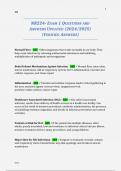1
NR
NR224- EXAM 1 QUESTIONS AND
ANSWERS UPDATED (2024/2025)
(VERIFIED ANSWERS)
Normal Flora - ANS ✓Microorganisms that reside normally in our body. They
help resist infection by releasing antibacterial substances and inhibiting
multiplication of pathogenic microorganisms
Body Defense Mechanisms Against Infection - ANS ✓Normal flora, intact skin,
mucus membranes, cilli in respiratory system, fever, inflammation, vascular and
cellular response, and tissue repair
Inflammation - ANS ✓Vascular and cellular response leads to blood gathering in
the area, exudates appear (serous=clear, sanguineous=red,
purulent=white/yellow), tissue repair
Healthcare-Associated Infection (HAI) - ANS ✓Also called nosocomial
infection, results from delivery of health services in a health care facility. Can
occur as the result of invasive procedures, antibiotic administration, the presence
of multidrug-resistant organisms, and breaks in infection prevention and control
activities
Patients at Risk for HAI - ANS ✓If the patient has multiple illnesses, older
adults, poorly nourished, lowered resistance to infection critical/chronic illness,
invasive treatment devices, many procedures, and young children
Major Sites for HAI Infections - ANS ✓Surgical or traumatic wounds, urinary
and respiratory tracts, bloodstream, any skin openings, and breaks in mucus
membranes
NR224
, 2
NR
Iatrogenic HAI - ANS ✓HAI from a diagnostic/therapeutic procedure
Ex) a dialysis patient repeatedly coming to the hospital, a patient with a
catheter inserted poorly or cleaned poorly
Exogenous - ANS ✓From microorganisms found outside the individual
Endogenous - ANS ✓Occurs when part of the client's flora becomes altered and
an overgrowth results
Ex) c.diff
Standard Precautions - ANS ✓Prevent and control infection and its spread.
Medical Asepsis - ANS ✓Controlling pathogen, hand hygiene, common on home,
ECF, assisted living
Sterile Asepsis - ANS ✓Killing or eliminating the pathogen, scrub (surgical), PPE
sterile handling, common in hospitals
Principles of Surgical Asepsis - ANS ✓1. A sterile object only remains sterile if
touched by another sterile object
2. Only sterile objects may be placed in a sterile field
3. A sterile object or field out of range of vision or an object held below a
persons waist is contaminated
4. A sterile object or field becomes contaminated by prolonged exposure to
air
5. When a sterile surface comes in contact with a wet, contaminated
surface, the sterile object or field becomes contaminated by capillary action
6. Fluid flows the in the direction of gravity
7. The edges of a sterile field or container are considered contaminated
NR224
, 3
NR
Disinfection - ANS ✓A process that eliminates many or all microorganisms, with
the exception of bacterial spores, from inanimate objects
Autoclave - ANS ✓A very high temperature disinfectious process, required for
some items like endoscopes
Sterilization - ANS ✓The complete elimination or destruction of all
microorganisms, including spores. Usually in an OR
Infection Prevention and Control - ANS ✓-Bathing
-Dressing changes (to prevent microorganism growth)
-Contaminated articles/sharps
-Bedside unit clean and dry
-Bottles solutions (keep closed, date, time and initial when you open it,
saline is only usable for 24 hours after opening)
-Hand hygiene
-Current vaccinations
-
Negative-Pressure Airflow - ANS ✓An isolation room that prevents
contaminated air from inside the room from flowing outside the room. It has a
filter that cleans air from inside the room before the air exits the room. It is used
in room that have patients with communicable diseases, especially airborne ones,
like TB
Positive-Pressure Airflow - ANS ✓Isolation rooms that filter the air going into
the room. It is used in patients who have compromised immune systems.
The Nursing Process - ANS ✓Assessment, diagnosis, planning, implementation,
evaluation
NR224




